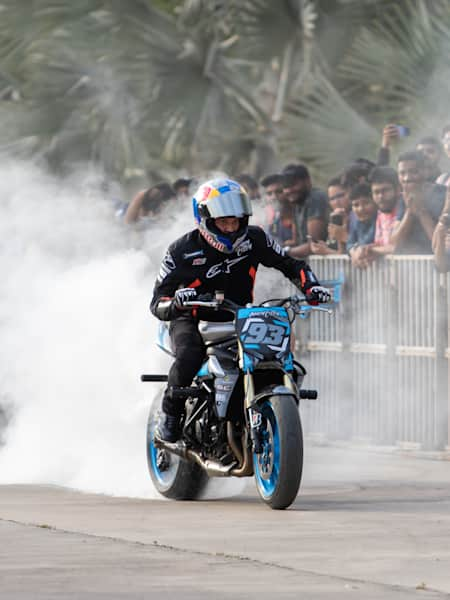The basic two-step process to achieve a burnout is: (1) hold down the front brake, and (2) hit the gas. But if it were that simple everyone would be doing it.
There is a certain finesse and expertise to it, which is lost on someone trying it for the first time. So we thought it would be best to speak with an expert to understand the nitty-gritty of a burnout.
While stunt rider Aaron Colton was in India for a few shows, we quizzed him about stunt riding in general, and about the famed burnout in particular.
The burnout is one of Aaron’s favourite tricks to pull off in freestyle stunt riding, so he was definitely excited to talk about it. He shared a few nuggets of information that he learnt over his illustrious career that can go a long way for anyone starting from scratch in trying to learn how to perform a burnout.
Any bike will do but more power helps
Start with the basics: the motorbike. Aaron says all shapes and sizes of a motorcycle can work for a burnout, but bikes with more power make it easier to achieve.
“Honestly, most of the 150cc bikes I see in India will do rolling burnouts with no issue as long as you can transfer your weight to the front of the motorcycle,” he says.
“You can also do one on a smaller bike, but the big fun starts from 450cc upwards.”
Higher tyre pressure makes it easier
When you start practising, use an older tyre because you are literally trying to burn the rubber off it – no point wasting the grip on a new tyre. Aaron also adds that the higher the tyre pressure, the easier it will be for the tyre to spin in a burnout.
“The normal pressure that you run on the street is good, but on my freestyle bikes that run the 180/70/17 tubeless tyres, I run 32psi in slick conditions and 38psi in higher grip conditions,” he says.
Switch to first gear
This is one of the basics that most people would recommend, and Aaron explains why.
“The first gear has the most torque and can break the tire loose the easiest in a burnout,” he says. So switch to first gear before starting the burnout.
Don’t start at full throttle
Aaron says it is best to give yourself some throttle space, especially when practising a rolling burnout.
“You can eventually go full throttle, but you must start first by feathering the clutch while the motorcycle is between half and three-quarter throttle. If you start the bike in a burnout with full throttle, it will have no room for you to change the speed in which you are doing a rolling burnout,” Aaron says.
Get a feel for the brakes
You must have good control on the brakes if you are going to be trying a burnout for the first time. Aaron suggests getting comfortable with a strong, modular front brake. For a static burnout, you can hold down the front brake entirely; a rolling burnout will need more control.
“If standing still, you engage the front brake 100%. If you are trying a rolling burnout, you can start by being in motion and gradually apply the brake until the rear wheel is able to break the tyre loose. This can range from 15% to 40% of the braking power,” he says.
Practice in an open field
A common idea is to practice a static burnout by propping the front wheel of the motorcycle against a wall. Aaron says that such a wall park can make it easier at first, but it can also cause the bike to hop aggressively because of the pressure on the suspension.
“In an area where absolutely nothing can be hit, and there is plenty of room to be able to correct mistakes, that’s the best way to practice,” he says. Suggestions are empty parking lots, clear tarmac roads without any other vehicles, abandoned racetracks or streets, etc.
Scale up from static to rolling burnouts
Aaron suggests starting with the basics and then levelling up. The basic would be the static burnout, and the natural progression is to practice a rolling burnout at slow speeds.
“Once you figure out how to do the static burnout, you start the rolling forward movement by gradually reducing the front brake until the bike is in motion. Apply more brake when needed to slow down and control the bike. Always remember the clutch is your safety net; if you pull the clutch in completely, the motorcycle will not move. It is very important to remember that,” is Aaron’s tip in progressing with your practice sessions.
Get fit to make it easier
This is something that most riders might not think about, but Aaron considers it important. He says he engages his core and arms the most, so it is important they are strong so that he can keep himself and the bike stable.
“I mainly do strength mobility training with my own body weight. This keeps me flexible and liquid on the motorcycle,” says Aaron.
Watch Aaron Colton rip through the streets of Mykonos in Greece with Robbie Maddison:

4 min
Rippin' Mykonos
Robbie Maddison and Aaron Colton do some alternative sightseeing on the Greek island of Mykonos.








